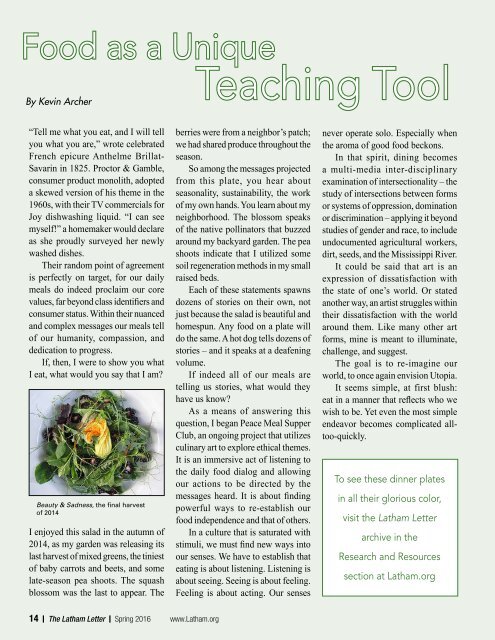Latham Letter
LL_16_SP
LL_16_SP
You also want an ePaper? Increase the reach of your titles
YUMPU automatically turns print PDFs into web optimized ePapers that Google loves.
Food as a Unique<br />
By Kevin Archer<br />
Teaching Tool<br />
“Tell me what you eat, and I will tell<br />
you what you are,” wrote celebrated<br />
French epicure Anthelme Brillat-<br />
Savarin in 1825. Proctor & Gamble,<br />
consumer product monolith, adopted<br />
a skewed version of his theme in the<br />
1960s, with their TV commercials for<br />
Joy dishwashing liquid. “I can see<br />
myself!” a homemaker would declare<br />
as she proudly surveyed her newly<br />
washed dishes.<br />
Their random point of agreement<br />
is perfectly on target, for our daily<br />
meals do indeed proclaim our core<br />
values, far beyond class identifiers and<br />
consumer status. Within their nuanced<br />
and complex messages our meals tell<br />
of our humanity, compassion, and<br />
dedication to progress.<br />
If, then, I were to show you what<br />
I eat, what would you say that I am?<br />
Beauty & Sadness, the final harvest<br />
of 2014<br />
I enjoyed this salad in the autumn of<br />
2014, as my garden was releasing its<br />
last harvest of mixed greens, the tiniest<br />
of baby carrots and beets, and some<br />
late-season pea shoots. The squash<br />
blossom was the last to appear. The<br />
berries were from a neighbor’s patch;<br />
we had shared produce throughout the<br />
season.<br />
So among the messages projected<br />
from this plate, you hear about<br />
seasonality, sustainability, the work<br />
of my own hands. You learn about my<br />
neighborhood. The blossom speaks<br />
of the native pollinators that buzzed<br />
around my backyard garden. The pea<br />
shoots indicate that I utilized some<br />
soil regeneration methods in my small<br />
raised beds.<br />
Each of these statements spawns<br />
dozens of stories on their own, not<br />
just because the salad is beautiful and<br />
homespun. Any food on a plate will<br />
do the same. A hot dog tells dozens of<br />
stories – and it speaks at a deafening<br />
volume.<br />
If indeed all of our meals are<br />
telling us stories, what would they<br />
have us know?<br />
As a means of answering this<br />
question, I began Peace Meal Supper<br />
Club, an ongoing project that utilizes<br />
culinary art to explore ethical themes.<br />
It is an immersive act of listening to<br />
the daily food dialog and allowing<br />
our actions to be directed by the<br />
messages heard. It is about finding<br />
powerful ways to re-establish our<br />
food independence and that of others.<br />
In a culture that is saturated with<br />
stimuli, we must find new ways into<br />
our senses. We have to establish that<br />
eating is about listening. Listening is<br />
about seeing. Seeing is about feeling.<br />
Feeling is about acting. Our senses<br />
never operate solo. Especially when<br />
the aroma of good food beckons.<br />
In that spirit, dining becomes<br />
a multi-media inter-disciplinary<br />
examination of intersectionality – the<br />
study of intersections between forms<br />
or systems of oppression, domination<br />
or discrimination – applying it beyond<br />
studies of gender and race, to include<br />
undocumented agricultural workers,<br />
dirt, seeds, and the Mississippi River.<br />
It could be said that art is an<br />
expression of dissatisfaction with<br />
the state of one’s world. Or stated<br />
another way, an artist struggles within<br />
their dissatisfaction with the world<br />
around them. Like many other art<br />
forms, mine is meant to illuminate,<br />
challenge, and suggest.<br />
The goal is to re-imagine our<br />
world, to once again envision Utopia.<br />
It seems simple, at first blush:<br />
eat in a manner that reflects who we<br />
wish to be. Yet even the most simple<br />
endeavor becomes complicated alltoo-quickly.<br />
To see these dinner plates<br />
in all their glorious color,<br />
visit the <strong>Latham</strong> <strong>Letter</strong><br />
archive in the<br />
Research and Resources<br />
section at <strong>Latham</strong>.org<br />
14 | The <strong>Latham</strong> <strong>Letter</strong> | Spring 2016 www.<strong>Latham</strong>.org


